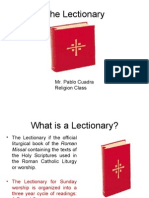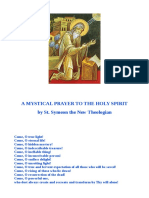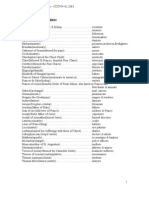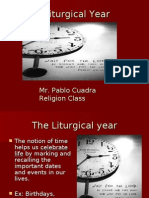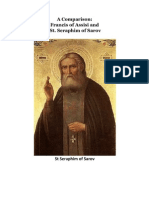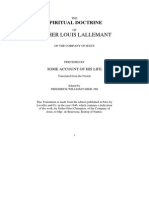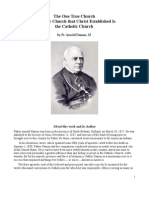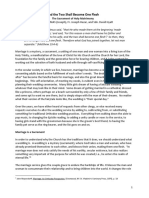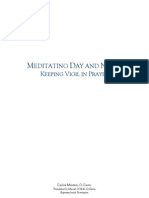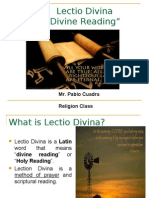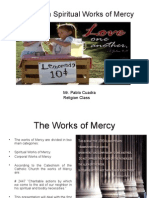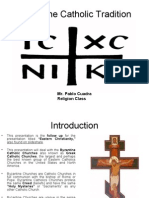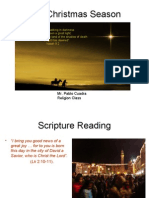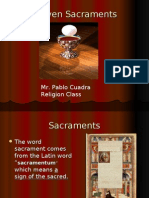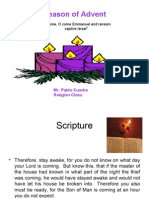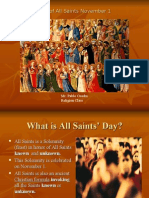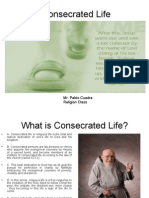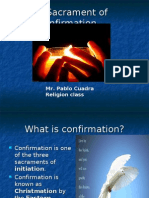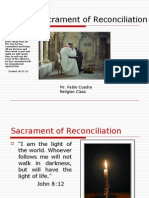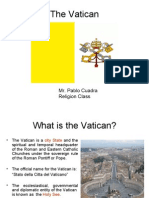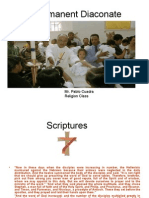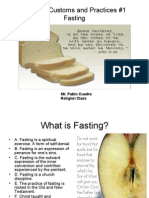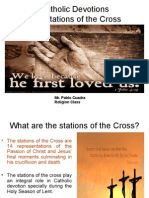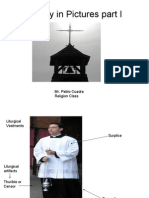100%(2)100% found this document useful (2 votes)
980 viewsThe Prayer Rope
The Prayer Rope
Uploaded by
Pablo CuadraThe prayer rope is a loop used in Eastern Christianity to count repetitions of the Jesus Prayer. It originated from the need to help monks pray the 150 Psalms daily. Saint Pachomius invented using pebbles in a bowl, while Saint Anthony devised the current practice of tying knots inspired by the Virgin Mary. Prayer ropes typically have 100 knots, though some have as many as 500, and are made of wool to symbolize Christ's flock. They are used by holding in the left hand while making signs of the cross with the right.
Copyright:
Attribution Non-Commercial (BY-NC)
Available Formats
Download as PPT, PDF, TXT or read online from Scribd
The Prayer Rope
The Prayer Rope
Uploaded by
Pablo Cuadra100%(2)100% found this document useful (2 votes)
980 views24 pagesThe prayer rope is a loop used in Eastern Christianity to count repetitions of the Jesus Prayer. It originated from the need to help monks pray the 150 Psalms daily. Saint Pachomius invented using pebbles in a bowl, while Saint Anthony devised the current practice of tying knots inspired by the Virgin Mary. Prayer ropes typically have 100 knots, though some have as many as 500, and are made of wool to symbolize Christ's flock. They are used by holding in the left hand while making signs of the cross with the right.
Copyright
© Attribution Non-Commercial (BY-NC)
Available Formats
PPT, PDF, TXT or read online from Scribd
Share this document
Did you find this document useful?
Is this content inappropriate?
The prayer rope is a loop used in Eastern Christianity to count repetitions of the Jesus Prayer. It originated from the need to help monks pray the 150 Psalms daily. Saint Pachomius invented using pebbles in a bowl, while Saint Anthony devised the current practice of tying knots inspired by the Virgin Mary. Prayer ropes typically have 100 knots, though some have as many as 500, and are made of wool to symbolize Christ's flock. They are used by holding in the left hand while making signs of the cross with the right.
Copyright:
Attribution Non-Commercial (BY-NC)
Available Formats
Download as PPT, PDF, TXT or read online from Scribd
Download as ppt, pdf, or txt
100%(2)100% found this document useful (2 votes)
980 views24 pagesThe Prayer Rope
The Prayer Rope
Uploaded by
Pablo CuadraThe prayer rope is a loop used in Eastern Christianity to count repetitions of the Jesus Prayer. It originated from the need to help monks pray the 150 Psalms daily. Saint Pachomius invented using pebbles in a bowl, while Saint Anthony devised the current practice of tying knots inspired by the Virgin Mary. Prayer ropes typically have 100 knots, though some have as many as 500, and are made of wool to symbolize Christ's flock. They are used by holding in the left hand while making signs of the cross with the right.
Copyright:
Attribution Non-Commercial (BY-NC)
Available Formats
Download as PPT, PDF, TXT or read online from Scribd
Download as ppt, pdf, or txt
You are on page 1of 24
The Prayer Rope
Mr. Pablo Cuadra
Religion Class
What is the prayer rope?
• A prayer rope is a loop
made up of complex
knots.
• It is used in Eastern
Catholic spirituality to
count the number of
times the Jesus prayer is
recited.
• This instrument of prayer
is also used by Orthodox
Christians.
• The prayer rope is known
as Komboskini in Greek.
What is the Jesus prayer?
• The Jesus prayer:
“ Lord Jesus Christ, son
of God have mercy on
me, a sinner.”
• The Jesus prayer is one
of the most profound
and perhaps mystical
prayers in Eastern
Catholicism.
• This prayer is often called the
prayer from the heart, by some
Fathers of the Church.
How many knots does a typical
prayer rope has?
• A prayer rope would
typically have 100 knots.
• There are several
variations, as to the
number of knots, some
ropes contain only 50,
others 33 knots.
• Some prayer ropes have
only 10 knots (intended to
be worn on the finger).
Did you know?
Some hermits have
prayer ropes with as
many as 500 knots in
them.
What is the general appearance of
a prayer rope?
• The prayer rope has a
knotted cross where the
rope is joined together to
form a loop.
• 10 to 25 beads are
placed at certain intervals
between the knots for
easy counting.
• Longer prayer ropes have
a tassel at the end of the
cross.
What is the meaning of the tassel
found in some prayer ropes?
• The purpose of the
tassel is devotional.
• To dry the tears shed
due to heartfelt
compunction of one’s
sins.
• It is also a symbol of
the Heavenly
Kingdom, which one
can only enter
through the cross.
What kind of material is used for
the creation of prayer ropes?
• The prayer rope is
commonly made out
of wool.
• Wool symbolizes the
flock of Christ.
• Materials other than
wool can also be
used.
Why is black the Traditional color of
the prayer rope?
• In Eastern Catholic
spirituality black
symbolizes the mourning
the penitent experiences
for his or her sins.
• The beads use to count
the Jesus prayer are also
black.
• The beads and a portion
of the tassel can also be
red to symbolize the
blood of Christ and his
martyrs.
What is the proper custom regarding
the creation of the prayer rope?
• Prayer ropes are usually
tied by monastics (monks
or nuns).
• Any lay person is
permitted to tie them also.
• The person tying a prayer
rope should be of true
faith, and pious life and
should be praying the
Jesus prayer during the
whole process.
How is the prayer rope used?
• During prayer, the
prayer rope is:
• A. Held in the left
hand.
• B. The right hand
should be free to
make the sign of the
cross.
How should one disposed of the
prayer rope when not in use?
• The prayer rope
should be wrapped
around the left wrist
so that it continues to
remind one to pray
without ceasing.
• It may also be placed
in the left pocket.
Why can’t the prayer rope be hung around
the neck or suspended from the belt?
• In Eastern Catholic
piety the reason is
humility.
• One should not be
ostentatious or
conspicuous in
displaying the prayer
rope for others to see.
When do monastics received the
prayer rope?
• The prayer rope is an
important symbol in
the Eastern Catholic
monastic tradition.
• Monks or Nuns are
given the prayer rope
after their tonsure.
What prayer is recited during the tonsure of a
monastic as the prayer rope is being given?
• “Accept, O brother/sister
(name), the sword of the Spirit
which is the word of God in the
everlasting Jesus prayer by
which you should have the
name of the Lord in your soul,
your thoughts, and your heart,
saying always: “Lord Jesus
Christ, Son of God, have
mercy on me a sinner.”
“The Church must breath with both lungs”
John Paul II
Did you know?
• In the Eastern Catholic as
well as in the Orthodox
churches some liturgical
services can be replaced
when necessary by
praying the Jesus prayer,
anywhere from 300 to
1,500 times depending on
the service being
replaced.
What is the origin of the prayer
rope?
• The history of the prayer rope is
rooted in Christian monasticism
which sprung in the deserts of
Egypt and flourished in the
Tradition of the East.
• It was customary for monks to
pray the entire 150 psalms
every day.
• The tradition of the prayer rope
and the recitation of the Jesus
prayer 150 times a day began, in
order to aid the monks, who were
unable to read and memorize all
150 psalms.
St. Pachomius
• The invention of the
prayer rope is
attributed to St.
Pachomius in the 4th
century.
• St. Pachomius is also
attributed with the
creation of monastic
communities.
Did you know?
• Prior to the creation of
the prayer rope by St.
Pachomius, monks
would count their
prayers by casting
pebbles into a bowl.
St. Anthony the Great
• The method of tying the prayer
rope had its origin from St.
Anthony the Great, the father
of monastic life.
• He devised a way of tying the
knots inspired by a vision of the
Theotokos or Mother of God,
the Blessed Virgin Mary.
• In this Vision Mary tied the
knots sot that the knots
themselves would constantly
make the sign of the Cross.
Did you know?
• St. Anthony’s vision
of the blessed virgin
Mary or Theotokos is
the source of today’s
practice of tying
prayer ropes using
knots that each
contain seven little
crosses being tied
over and over.
Devotion
• According to Eastern
Catholic devotion, the
devil cannot untie the
knots in prayer knot
because the Devil is
vanquished by the
sign of the Cross.
What happened to the prayer rope
in the West?
• In the western church
the prayer rope
evolved into the
Rosary.
The Jesus Prayer
“Lord Jesus Christ, Son of God, have mercy on me a
sinner.”
For more presentations please visit:
http://www.slideshare.net/pcuadra/slideshows
You might also like
- Bro. Francis HermitDocument7 pagesBro. Francis HermitCydryl A MonsantoNo ratings yet
- Three Ages of Interior LifeDocument643 pagesThree Ages of Interior LifeRoqueRaul100% (1)
- WR Pocket Prayer Book WebDocument280 pagesWR Pocket Prayer Book WebLengteng SooNo ratings yet
- A Key To The Doctrine of The EucharistDocument75 pagesA Key To The Doctrine of The Eucharisthelphope100% (1)
- St. Joseph ParaklesisDocument15 pagesSt. Joseph Paraklesisdanielhoulis100% (1)
- 7 Secrets of ConfessionDocument9 pages7 Secrets of Confessionsophia_stephy9478No ratings yet
- Pages From Counsels From The Holy Mountain On Prayer PDFDocument43 pagesPages From Counsels From The Holy Mountain On Prayer PDFCola Nicea100% (1)
- The LectionaryDocument17 pagesThe LectionaryPablo CuadraNo ratings yet
- A Mystical Prayer To The Holy Spirit by St. Symeon The New TheologianDocument3 pagesA Mystical Prayer To The Holy Spirit by St. Symeon The New TheologianChristos100% (1)
- Kallistos Prayer of The HeartDocument22 pagesKallistos Prayer of The HeartMirela Dragos100% (2)
- 252 A Charade of SaintsDocument4 pages252 A Charade of SaintsMa Elena UmaliNo ratings yet
- Divine Eros in The Counsels of Saint Porphyrios The New PDFDocument5 pagesDivine Eros in The Counsels of Saint Porphyrios The New PDFLeonard Enkeleida Doka100% (1)
- Silence in The Sacred LiturgyDocument18 pagesSilence in The Sacred Liturgynjknutson3248100% (1)
- Joseph Wong - The Jesus Prayer and Inner StillnessDocument14 pagesJoseph Wong - The Jesus Prayer and Inner StillnessChris Schelin100% (3)
- The Liturgical YearDocument15 pagesThe Liturgical YearPablo CuadraNo ratings yet
- Nurse EcmoDocument124 pagesNurse EcmoSalvatore Cimino100% (5)
- The Prayer Rope: Meditations of A Monk of The Holy Mountain AthosDocument2 pagesThe Prayer Rope: Meditations of A Monk of The Holy Mountain Athoseagle4a4100% (1)
- Wisdom from the Holy Mountain: Life Lessons from the Monks of Mt. AthosFrom EverandWisdom from the Holy Mountain: Life Lessons from the Monks of Mt. AthosNo ratings yet
- A Comparison: Francis of Assisi and St. Seraphim of SarovDocument18 pagesA Comparison: Francis of Assisi and St. Seraphim of SarovИоанн Дойг100% (2)
- Orthodoxs ServicesDocument16 pagesOrthodoxs ServicesfabianNo ratings yet
- The Jesus Prayer - Lev GilletDocument20 pagesThe Jesus Prayer - Lev GilletAlex ZammitNo ratings yet
- Hesychasm, The Jesus Prayer, and The KomboskiniDocument2 pagesHesychasm, The Jesus Prayer, and The KomboskiniMario BaghosNo ratings yet
- Catholic Doctrinal ConcordanceDocument30 pagesCatholic Doctrinal ConcordanceGleNn Episcope100% (1)
- On Prayer - Saint Isaac The SyrianDocument4 pagesOn Prayer - Saint Isaac The Syriansean griffin100% (1)
- Brief Form For Private UseDocument7 pagesBrief Form For Private UseArchbishop Dominic Martin100% (1)
- Brianchaninov Jesus PrayerDocument4 pagesBrianchaninov Jesus Prayerbyzntn1100% (1)
- The Order For The Celebration of The Restored Western Orthodox LiturgyDocument27 pagesThe Order For The Celebration of The Restored Western Orthodox LiturgyPleasant Karl50% (2)
- Rosary To Saint JosephDocument6 pagesRosary To Saint JosephJohn Carl AparicioNo ratings yet
- Carthusian LitanyDocument6 pagesCarthusian Litanyvargus12No ratings yet
- 7 Times Santa Veronica Giuliani Has Been in PurgatoryDocument8 pages7 Times Santa Veronica Giuliani Has Been in PurgatoryNurli GirsangNo ratings yet
- Catholic Catechism of Saint Pius XDocument119 pagesCatholic Catechism of Saint Pius XJoséluisNo ratings yet
- The Way of Spritual Transformation - Fr. DamasceneDocument21 pagesThe Way of Spritual Transformation - Fr. Damascenejckstraw72100% (1)
- Old Roman MissalDocument35 pagesOld Roman MissalBrendan-Michael HammacherNo ratings yet
- Ambrosian Rite PDFDocument15 pagesAmbrosian Rite PDFweyerNo ratings yet
- The Spiritual Doctrine of Father Louis Lallemant, Louis, 1588-1635Document334 pagesThe Spiritual Doctrine of Father Louis Lallemant, Louis, 1588-1635RoqueRaul100% (1)
- The Life and Witness of St. Maria Goretti - Our Little Saint of The Beatitudes - Fr. Jeffrey KirbyDocument56 pagesThe Life and Witness of St. Maria Goretti - Our Little Saint of The Beatitudes - Fr. Jeffrey KirbyChristine SinclairNo ratings yet
- The One True Church The Only Church That Christ Established Is The Catholic Church by Fr. Arnold Damen, SJDocument10 pagesThe One True Church The Only Church That Christ Established Is The Catholic Church by Fr. Arnold Damen, SJExtraEcclesiamNullaSalus100% (1)
- Breviarium Monasticum (Cluniac)Document853 pagesBreviarium Monasticum (Cluniac)Monachus Ignotus100% (2)
- The Jesus Prayer Participants BookDocument8 pagesThe Jesus Prayer Participants BookDenis Alibor MajhenNo ratings yet
- Prayer Divine Mercy Prayer Book KC CatholicDocument23 pagesPrayer Divine Mercy Prayer Book KC CatholicDionisio Carmo-Neto100% (3)
- The Two Shall Become One FleshDocument5 pagesThe Two Shall Become One FleshBill BillsonNo ratings yet
- The Saints of The Orthodox ChurchDocument7 pagesThe Saints of The Orthodox ChurchNathanaela Esporlas FarenasNo ratings yet
- 24 Reasons For Spending An Hour With Jesus in The Blessed SacramentDocument2 pages24 Reasons For Spending An Hour With Jesus in The Blessed SacramentJane Eyre San Miguel100% (1)
- Blessing and Investiture of Miraculous MedalDocument3 pagesBlessing and Investiture of Miraculous MedalJERONIMO PAPA100% (1)
- Poor Clare Nuns Anthology PDFDocument96 pagesPoor Clare Nuns Anthology PDFMary Francis Hone100% (2)
- The Romanian Philokalia Volume IVDocument294 pagesThe Romanian Philokalia Volume IVRareș Golea100% (1)
- Prayer Book 2010 PDFDocument240 pagesPrayer Book 2010 PDFDavid AndrewNo ratings yet
- Thy Will Be DoneDocument4 pagesThy Will Be DoneTerri Thomas100% (1)
- Holy Communion in The Methodist Church: His Presence Makes The Feast'Document55 pagesHoly Communion in The Methodist Church: His Presence Makes The Feast'Reinaldo de SouzaNo ratings yet
- A Manual of Ascetical TheologyDocument650 pagesA Manual of Ascetical TheologykidproquoNo ratings yet
- Last JudgmentDocument10 pagesLast JudgmentJason TiongcoNo ratings yet
- A Treasury of Indulgenced PrayersDocument14 pagesA Treasury of Indulgenced Prayerssalveregina1917100% (1)
- Carthusian Office of The Blessed VirginDocument48 pagesCarthusian Office of The Blessed VirginAldrin SagabaenNo ratings yet
- Rite For Spiritual Communion in The Absence of A PriestDocument7 pagesRite For Spiritual Communion in The Absence of A Priestacerfootball2135No ratings yet
- Jesus Prayer Brochure PDFDocument2 pagesJesus Prayer Brochure PDFDionNo ratings yet
- 12 Prayers ST BrigitDocument0 pages12 Prayers ST Brigitnnngan2100% (1)
- Meditating Day and NightDocument11 pagesMeditating Day and NightIrisGuiang100% (1)
- A Hesychasm Before Hesychasm PDFDocument11 pagesA Hesychasm Before Hesychasm PDFStelian-Alin DumitruNo ratings yet
- Philokalia IIIDocument489 pagesPhilokalia IIIRareș Golea100% (1)
- Scriptural Rosary of The BVM - LAPDocument49 pagesScriptural Rosary of The BVM - LAPChristian VieryNo ratings yet
- Antony and The Desert FathersDocument45 pagesAntony and The Desert Fathersmadsheep01100% (1)
- Lectio DivinaDocument17 pagesLectio DivinaPablo Cuadra100% (1)
- Essential Catholic Quiz IDocument56 pagesEssential Catholic Quiz IPablo CuadraNo ratings yet
- The Spiritual Works of MercyDocument19 pagesThe Spiritual Works of MercyPablo CuadraNo ratings yet
- Byzantine CatholicsDocument53 pagesByzantine CatholicsPablo CuadraNo ratings yet
- TheotokosDocument22 pagesTheotokosPablo Cuadra100% (2)
- The BibleDocument49 pagesThe BiblePablo CuadraNo ratings yet
- The Christmas SeasonDocument22 pagesThe Christmas SeasonPablo Cuadra100% (1)
- Holy TriddumDocument21 pagesHoly TriddumPablo CuadraNo ratings yet
- Ordinary TimeDocument19 pagesOrdinary TimePablo Cuadra100% (2)
- The Seven SacramentsDocument17 pagesThe Seven SacramentsPablo Cuadra100% (1)
- The Season of AdventDocument22 pagesThe Season of AdventPablo Cuadra0% (1)
- Solemnity of All SaintsDocument21 pagesSolemnity of All SaintsPablo CuadraNo ratings yet
- Religious LifeDocument30 pagesReligious LifePablo Cuadra100% (3)
- Sacrament of ConfirmationDocument41 pagesSacrament of ConfirmationPablo CuadraNo ratings yet
- The Season of LentDocument33 pagesThe Season of LentPablo CuadraNo ratings yet
- ChastityDocument18 pagesChastityPablo CuadraNo ratings yet
- TheotokosDocument22 pagesTheotokosPablo Cuadra100% (2)
- Sacrament of ReconciliationDocument25 pagesSacrament of ReconciliationPablo Cuadra100% (1)
- The VaticanDocument34 pagesThe VaticanPablo Cuadra100% (2)
- SacramentalsDocument11 pagesSacramentalsPablo Cuadra0% (1)
- The Bishop's InsigniasDocument23 pagesThe Bishop's InsigniasPablo CuadraNo ratings yet
- The Permanent Diaconate: Mr. Pablo Cuadra Religion ClassDocument20 pagesThe Permanent Diaconate: Mr. Pablo Cuadra Religion ClassPablo CuadraNo ratings yet
- Catholic Customs and Practices #1 Fasting: Mr. Pablo Cuadra Religion ClassDocument16 pagesCatholic Customs and Practices #1 Fasting: Mr. Pablo Cuadra Religion ClassPablo Cuadra100% (1)
- The Effects of PornographyDocument33 pagesThe Effects of PornographyPablo Cuadra20% (5)
- Catholic Devotions:The Stations of The CrossDocument21 pagesCatholic Devotions:The Stations of The CrossPablo Cuadra100% (3)
- Catholicity in Pictures Part I: Mr. Pablo Cuadra Religion ClassDocument46 pagesCatholicity in Pictures Part I: Mr. Pablo Cuadra Religion ClassPablo CuadraNo ratings yet
- Christian Moral LivingDocument35 pagesChristian Moral LivingPablo CuadraNo ratings yet
- The Golden RuleDocument23 pagesThe Golden RulePablo Cuadra100% (2)
- BEEA MT1 Exam-QuestionsDocument38 pagesBEEA MT1 Exam-QuestionsSofhia Claire YbañezNo ratings yet
- Modal Verbs of Ability WorksheetDocument2 pagesModal Verbs of Ability WorksheetAlba LinetteNo ratings yet
- Corning Single Panel Housing - Standard Recommended Procedure 003-981-AENDocument2 pagesCorning Single Panel Housing - Standard Recommended Procedure 003-981-AENmarkNo ratings yet
- JubiliantDocument4 pagesJubiliantabhiman beheraNo ratings yet
- 13.09.2022 TMS - Brochure - NewDocument7 pages13.09.2022 TMS - Brochure - Neweliseekoj03No ratings yet
- BME2303 Tutorial 2Document6 pagesBME2303 Tutorial 2Zarif IzzatNo ratings yet
- Department of Systems Engineering Faculty of Engineering University of LagosDocument42 pagesDepartment of Systems Engineering Faculty of Engineering University of LagosJesse QuartNo ratings yet
- Green and While RevolutionDocument11 pagesGreen and While RevolutionMukesh KumarNo ratings yet
- Multivariate Behavioral Research: To Cite This Article: Stanley A. Mulaik (1990) : Blurring The Distinctions BetweenDocument8 pagesMultivariate Behavioral Research: To Cite This Article: Stanley A. Mulaik (1990) : Blurring The Distinctions BetweenAcatalepsoNo ratings yet
- Giua HK2 - K12 - 21-22Document5 pagesGiua HK2 - K12 - 21-22Trần PhươngNo ratings yet
- Tulip Olsen 17: Ranger 8 Bárbara Human 34000Document3 pagesTulip Olsen 17: Ranger 8 Bárbara Human 34000WaffleTimeNo ratings yet
- 7 SegmentDocument3 pages7 Segmentyassinahmad851No ratings yet
- BTS3900 Monitoring SystemDocument16 pagesBTS3900 Monitoring SystemkikirnNo ratings yet
- Ap2004 PDFDocument6 pagesAp2004 PDFSUDARSHAN dAWNo ratings yet
- Iso 6611 2012Document13 pagesIso 6611 2012Angel Moore100% (1)
- Honda Fault CodesDocument46 pagesHonda Fault Codeskarisma duaNo ratings yet
- FC Path (SA) Anat Part II Past Papers - 2020 1st Semester 8 5 2021Document4 pagesFC Path (SA) Anat Part II Past Papers - 2020 1st Semester 8 5 2021Ray ChimatiraNo ratings yet
- Tuberculosis NclexDocument3 pagesTuberculosis NclexMarinill SolimanNo ratings yet
- 4TH QTR GR 5 Sy 21-22Document37 pages4TH QTR GR 5 Sy 21-22Paula Mae ManriqueNo ratings yet
- Gazette International 25Document156 pagesGazette International 25Nándor Ferencz Nagy100% (1)
- Volvo February 2014 New Monthly Releases PV776-K-D16F Engine TOC PDFDocument5 pagesVolvo February 2014 New Monthly Releases PV776-K-D16F Engine TOC PDFCesar Bayes RamosNo ratings yet
- Saf XTDocument4 pagesSaf XTAnonymous roK5l6uvNo ratings yet
- Ds0962117-0208902 Monitor 7in Rled RC 4 Cs en A02Document2 pagesDs0962117-0208902 Monitor 7in Rled RC 4 Cs en A02Nhàn Nguyễn ThanhNo ratings yet
- A Survey of Drowning Detection TechniquesDocument5 pagesA Survey of Drowning Detection TechniquesSachin BharadwajNo ratings yet
- Report Wastewater 2025 26Document23 pagesReport Wastewater 2025 26ganesh786786No ratings yet
- Solutions Assignment 7Document7 pagesSolutions Assignment 7Sammei DanniyelNo ratings yet
- Slab Design Code A: InputDocument12 pagesSlab Design Code A: InputjatinNo ratings yet
- 077 YogasDocument1 page077 YogasNeoHoodaNo ratings yet
- MS Sas 4Document5 pagesMS Sas 4rereNo ratings yet







